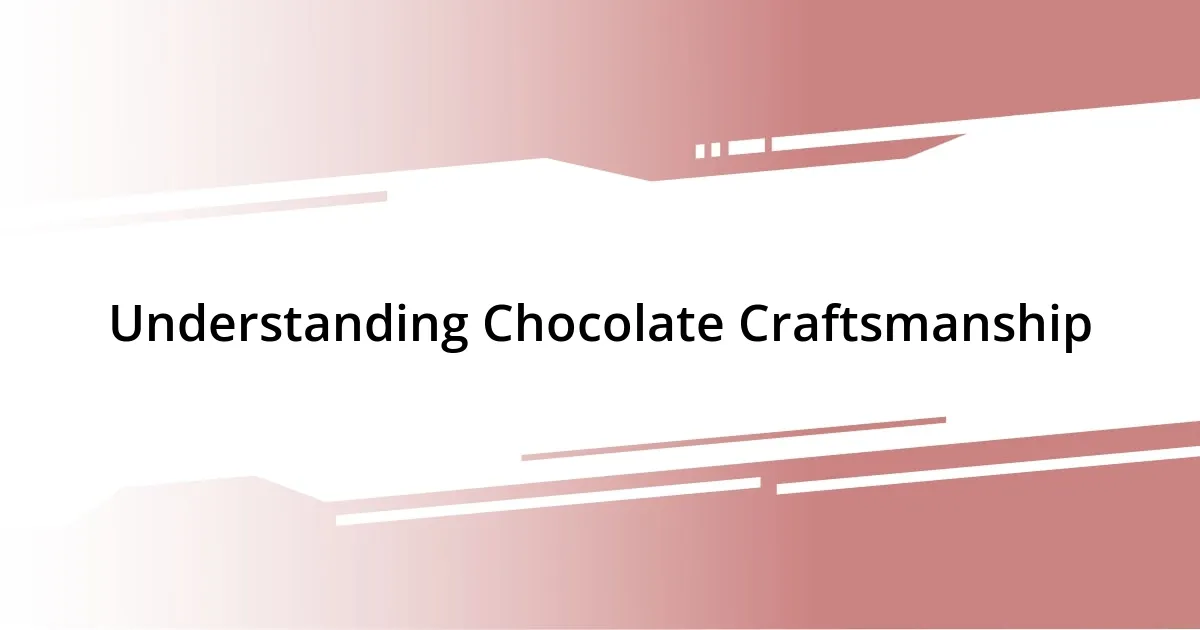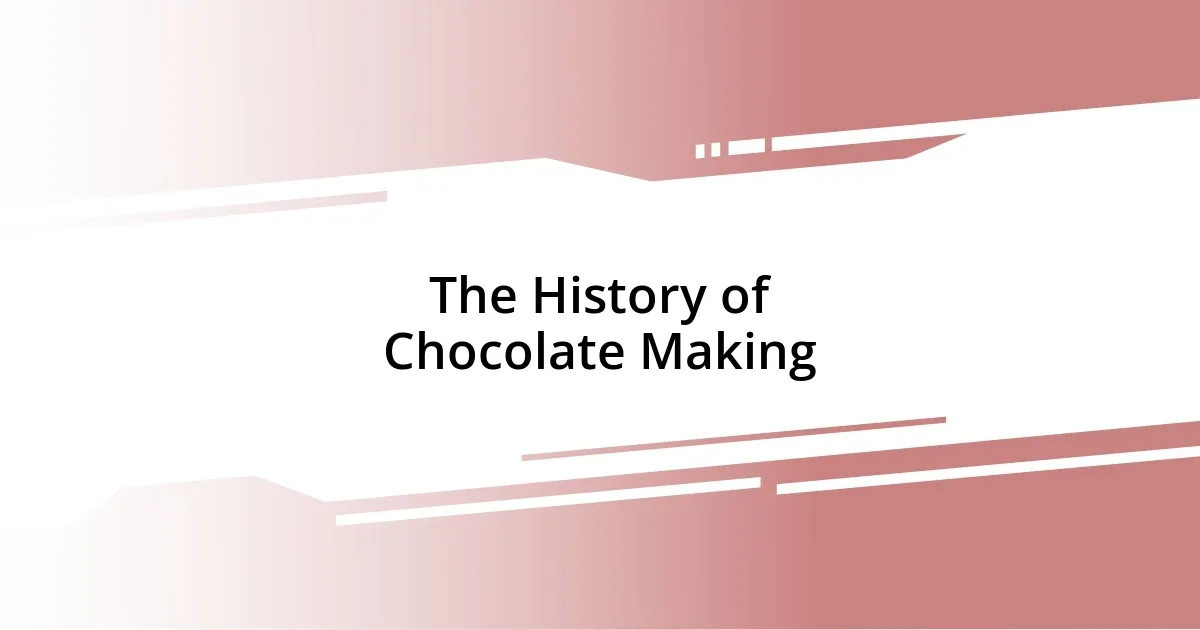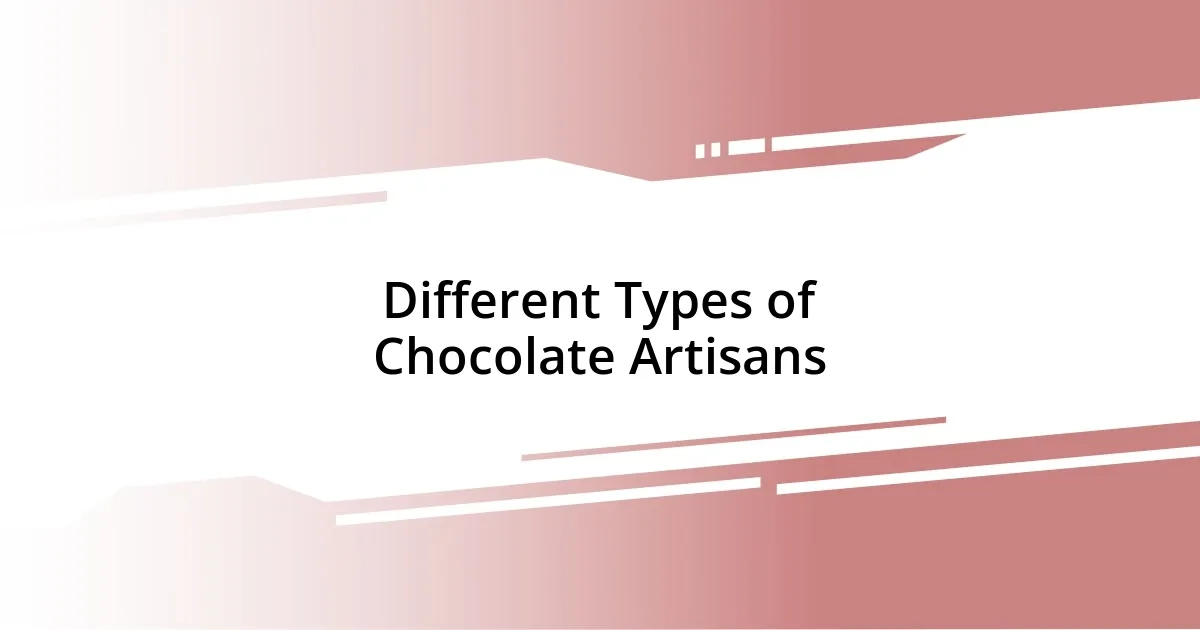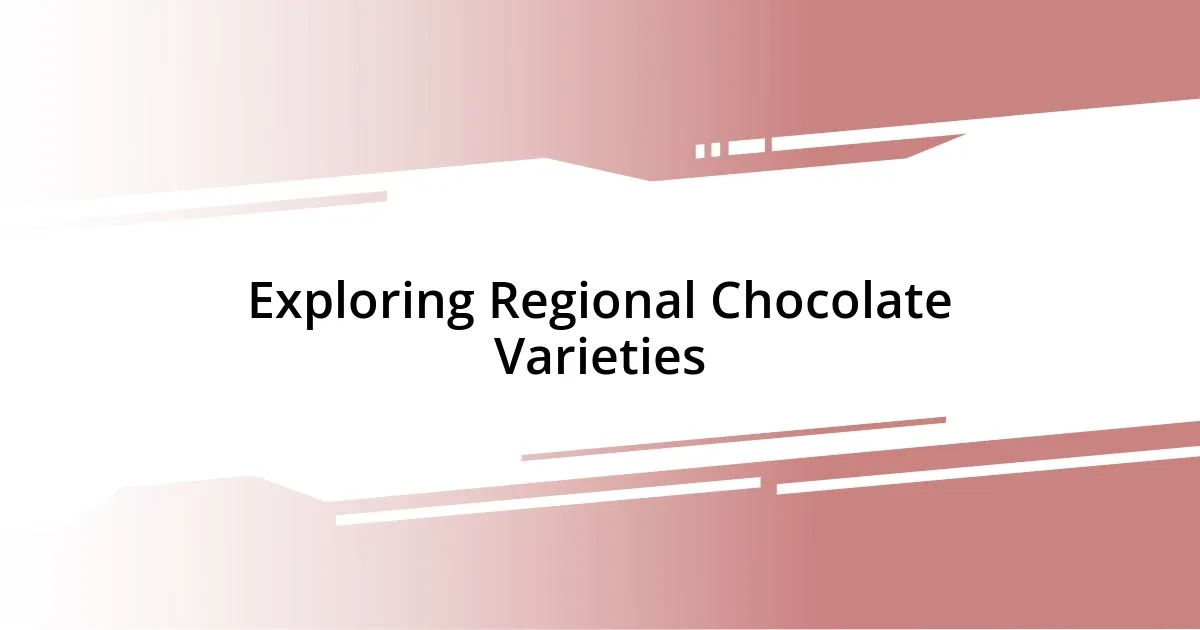Key takeaways:
- Chocolate craftsmanship involves intricate techniques like tempering, ganache preparation, and molding, which significantly influence the final product.
- The history of chocolate traces back to Mesoamerican civilizations, evolving through European introduction and technological advancements in the 19th century.
- Quality ingredients, including ethically sourced cacao, are crucial in enhancing flavor and creating a meaningful chocolate experience.
- Different types of chocolate artisans—traditional, modern, and bean-to-bar—each bring unique styles and philosophies to chocolate making.

Understanding Chocolate Craftsmanship
When I first delved into the world of chocolate craftsmanship, I was struck by the intricacy involved in transforming raw cacao beans into exquisite confections. It’s not just about melting chocolate; it’s about understanding the nuanced balance of flavors, textures, and techniques. Have you ever wondered how a chocolatier can evoke such depth in a simple bar of chocolate?
Each stage of the chocolate-making process holds significance, from sourcing high-quality beans to perfecting the tempering technique. I remember visiting a local chocolatier, where I witnessed firsthand the dedication and precision that goes into every piece. The chocolatier passionately explained how the origin of the cacao impacts the flavor profile, a detail that might go unnoticed by most but was a game changer in my appreciation for the craft.
As I began experimenting with making my own chocolates, I realized that it requires not just skill but an emotional connection to the ingredients. The joy of creating a perfect ganache or the satisfaction of seeing someone’s eyes light up at the taste of your chocolate is an experience like no other. Isn’t it fascinating how something as simple as chocolate can weave a tapestry of creativity and passion?

The History of Chocolate Making
The journey of chocolate making begins thousands of years ago with the ancient civilizations of Mesoamerica. The Mayans and Aztecs revered cacao, using it not just as a food source, but as currency and in sacred rituals. I once read about an Aztec ruler who drank a frothy cup of chocolate, made from cacao beans, flavored with spices. You can almost feel the reverence in the air as he savored a drink exclusive to the elite.
- Cacao cultivation began around 1500 BC in Mesoamerica.
- The arrival of Europeans in the 16th century introduced chocolate to Europe.
- In the 19th century, chocolate started to be produced on a larger scale, thanks to advances in technology.
- The advent of solid chocolate in the mid-1800s transformed it into the beloved treat we know today.
I remember tasting my first piece of artisanal chocolate, and it instantly transported me back in time, imagining those ancient rituals and the very roots of this delicacy. Understanding chocolate’s rich history connects me deeper to its craftsmanship and evokes a sense of legacy that I find truly inspiring.

Key Techniques in Chocolate Crafting
The art of chocolate crafting relies heavily on a few key techniques that can make or break the final product. One of the fundamentals is tempering, a process that involves carefully heating and cooling chocolate to stabilize it. I vividly remember my initial attempts at tempering; it felt like a delicate dance, and I was thrilled when my chocolate set perfectly, yielding that glossy finish and satisfying snap. It’s moments like these that remind me how significant these techniques are, transforming simple ingredients into something extraordinary.
Another crucial technique is ganache preparation, which marries chocolate and cream to create a luscious, velvety filling for various confections. I often experiment with different ratios and flavors, and each time, it feels like unearthing a hidden treasure. The way a richer ganache melts in your mouth can evoke emotions and memories, making it a personal journey every chocolatier embarks on.
Lastly, let’s not forget the role of molding in chocolate crafting. It’s not just about creating shapes; it’s about capturing the essence of the chocolatier’s vision. I remember the thrill of using intricate molds for the first time; watching the liquid chocolate transform into beautiful pieces filled me with pride. Each technique intertwines with creativity and skill, leading to an end product that reflects both art and passion.
| Technique | Description |
|---|---|
| Tempering | Heating and cooling chocolate to stabilize it for a shiny finish. |
| Ganache Preparation | Combining chocolate with cream to create a rich filling. |
| Molding | Shaping chocolate into various forms, showcasing creativity. |

Importance of Quality Ingredients
When it comes to chocolate craftsmanship, the importance of quality ingredients cannot be overstated. I often find myself reflecting on the deep differences between mass-produced chocolate and artisan varieties. Just the other day, I treated myself to a bar made with single-origin cacao. The moment it melted on my tongue, I was struck by the complex flavor notes that danced together—those subtle fruity hints were simply divine! It made me wonder, how often do we truly pause to appreciate the source of what we consume?
High-quality ingredients not only enhance flavor but also contribute to the overall experience. I vividly recall an afternoon spent at a local chocolatier, where I watched them select the finest Madagascar vanilla to pair with their dark chocolate. The aroma filled the air, creating an inviting atmosphere. It reminded me that top-notch ingredients, like high-quality cacao and pure vanilla, elevate chocolate from just a treat to an extraordinary sensory experience.
Moreover, the ethical sourcing of ingredients plays a crucial role in the chocolate community. I’ve become increasingly aware of the positive impact of supporting cacao farmers who practice sustainable methods. Each bite of ethically sourced chocolate tells a story—one of care for the earth and its people. It makes me feel good to know that my appreciation for chocolate also supports communities and keeps traditions alive. Isn’t it incredible how the choices we make while indulging in something we love can resonate far beyond our taste buds?

Different Types of Chocolate Artisans
While exploring the world of chocolate artisans, I find it fascinating how distinct styles emerge based on their backgrounds and philosophies. For instance, some chocolatiers pride themselves on traditional techniques, often passed down through generations. I remember visiting an artisan who meticulously handcrafted pralines, each one a miniature work of art, fluttering between nostalgia and innovation. The passion behind their craft truly resonated with me; watching them work was like seeing history come to life.
Then, there’s the modern artisan, who embraces a more experimental approach. These chocolatiers often incorporate unexpected flavors and techniques, making each creation a unique experience. Just the other day, I tried a chocolate infused with wasabi. To my delight, it wasn’t just a jarring taste; it created an exhilarating balance that danced on my palate. Have you ever found yourself surprised by a flavor combination? It’s moments like these that reveal the endless possibilities within chocolate craftsmanship.
Lastly, we can’t overlook the bean-to-bar artisans. They’re influential in elevating the standards of chocolate by controlling the entire process from sourcing the cacao beans to final production. I had the chance to visit a small bean-to-bar shop, and I was captivated by their dedication to transparency and quality. Witnessing the process—from cracking open raw beans to grinding them into smooth chocolate—was a transformative experience that deepened my appreciation for every bite I take. Isn’t it amazing how each type of artisan contributes to the rich tapestry of chocolate culture?

Exploring Regional Chocolate Varieties
As I delve into the rich tapestry of regional chocolate varieties, I’m often struck by how local climates and cultures shape unique flavor profiles. During a trip to Ecuador, I had the pleasure of tasting chocolate made from Arriba Nacional cacao. The notes of floral and citrus left a lingering impression, as if the essence of the land was infused in every bite. It made me ponder how much our environment influences what we produce—have you ever thought about the stories that flavors tell?
One of my most memorable chocolate experiences happened in Switzerland, known for its velvety smooth chocolates. I visited a small workshop nestled in the Alps where they utilized cow’s milk to create a delightful milk chocolate with a creamy texture. The chocolatier shared that this technique has been passed down through generations. Watching him blend ingredients, I felt a connection to time-honored traditions. Isn’t it amazing how each region celebrates its heritage through the medium of chocolate?
In contrast, I stumbled upon a vibrant chocolate scene in Indonesia, where the use of unique spices sets their chocolate apart. I tasted a bar infused with local ginger, resulting in a spicy kick that was both surprising and satisfying. It was a vivid reminder of how chocolate can be a canvas for regional ingredients. Have you experienced a flavor that totally transformed your view of chocolate? I certainly have, and it’s these regional varieties that keep me continuously enchanted with the world of chocolate craftsmanship.














